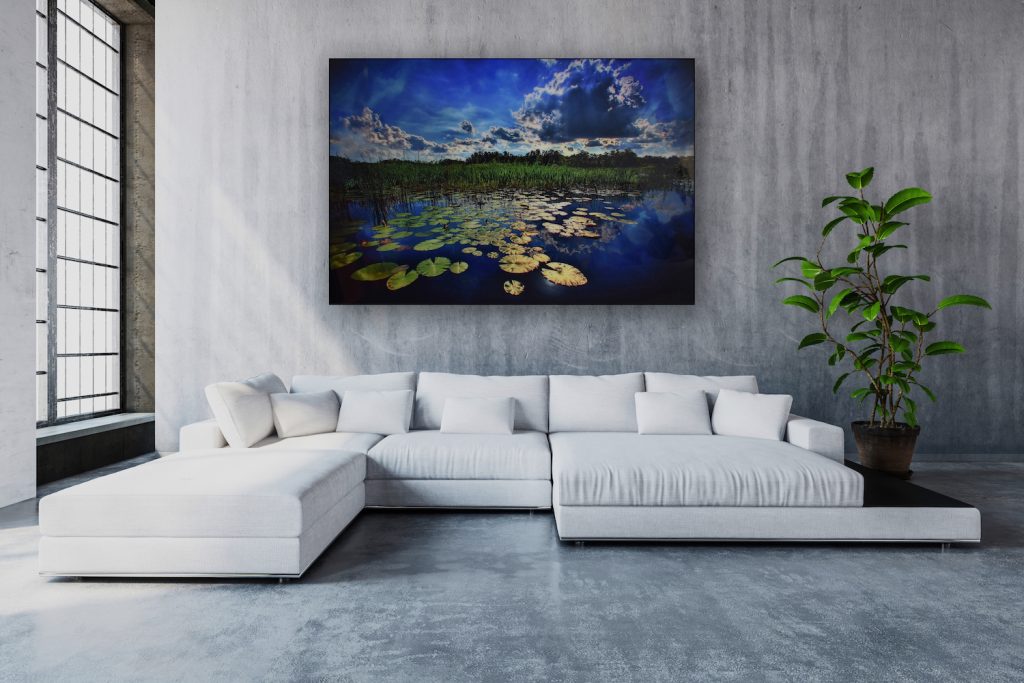Acrylic or Glass Prints?
There are a ton of websites out there that sell acrylic or glass prints. But few websites talk about the difference between the mediums. That’s why the focus of this week’s blog post provides the pros and cons to help you decide if acrylic or glass works better for you.
We wanted to make the discussion as simple as possible, so we discuss each medium with their pros and cons.

Acrylic
What is Acrylic?
Acrylic is a type of synthetic material found everywhere in our world. As a panel, acrylic is a material for photo printing, windows, screens, or other glass replacements. In these functions, it’s usually called “Plexiglass.” It is such a versatile substance that textile and paint manufacturing use acrylic fibres.
Developed in 1928, acrylic gained a lot of traction as a low-cost replacement for glass. Especially in military functions. Since acrylic is more durable than glass, and shatters in a distinct dull-edged manner, it was considered a safer material to use for periscopes, airplane windows, and even eyeglass lenses than standard glass.
Although it is a synthetic material, acrylic is quite safe to be around. Surgeons even use pieces of acrylic in some transplant surgeries due to the low rejection rate.
Pros of Acrylic
Due to the many uses, acrylic has quite a few pros. A few of them include, but are not limited to
- durability
- easy to manipulate, cut, or alter
- lightweight
- light reflection and transparency
- cost-efficiency
- rigidity and flexibility
Acrylic provides a lot of advantages. It maintains its shape, rigidly, but it can also be bent, curved, or altered without shattering. Since it is a synthetic product with little effort put into manufacturing, it is quite cost-efficient, but reflects light or maintains transparency in a manner almost identical to glass. This means it is a perfect material for acrylic photo prints.
Additionally, if acrylic breaks, it often does so in larger fragments with dulled edges. This reduces the risk of injury, and makes clean-up a lot easier. “If” acting as the operative word in that sentence. Acrylics are incredibly resistant to breakage, scratches, and dents, meaning that they last a long time without needing to be replaced.
Cons
We don’t know much about how acrylic breaks down in the environment. Fortunately, some recent studies show some bacteria breaking down acrylic materials.
Otherwise, there are very few cons to acrylic, which is why is has endured as a material and made its way into our everyday life.
Glass
What is glass?
Glass is a naturally-occurring solid that is made from melting silica crystals into a molten form. Like acrylic, glass has a permanent place in our society, and has for thousands of years.
Pros of Glass
As a material, glass has tons of pros, including, but not limited to:
- heat transfer
- clarity
- rigidity and flexibility
- versatility
- prettiness
- eco-friendliness
Like acrylic, glass offers many, many pros. However, glass may have a few more cons.
Cons of Glass
Glass is heavier and more fragile than acrylic. Additionally, glass is much more expensive. While these two cons don’t seem important at first, they are very important factors when deciding between acrylic or glass prints.
Acrylic or Glass Prints: What’s the Verdict?
So we’ve weighed the pros and cons for each medium. Now it’s time to see how they fare when making a print.
Due to the extra weight and fragility, most manufacturers offer glass prints in small sizes that are no bigger than regular print photos. For a larger print on glass, you can expect to pay more in materials, and much more in shipping. There is also an increased risk of breakage and injury with a glass print, as they are less durable than acrylic.
Acrylic prints are very lightweight, resulting in a lower cost in both shipping and material. The panels can also be cut to much larger sizes. For example, Big Acrylic can produce images up to 60″ by 90″. Acrylic prints have all the benefits of glass prints: transparency, clarity, and vibrant color display. But, they are lighter, more cost-efficient, more durable, and can be altered more easily.
Ultimately, the decision is yours! We hope that we were able to help you decide which medium is better for acrylic or glass prints. If you have any questions, don’t hesitate to contact us!




